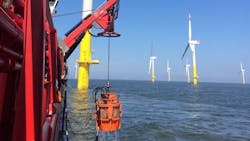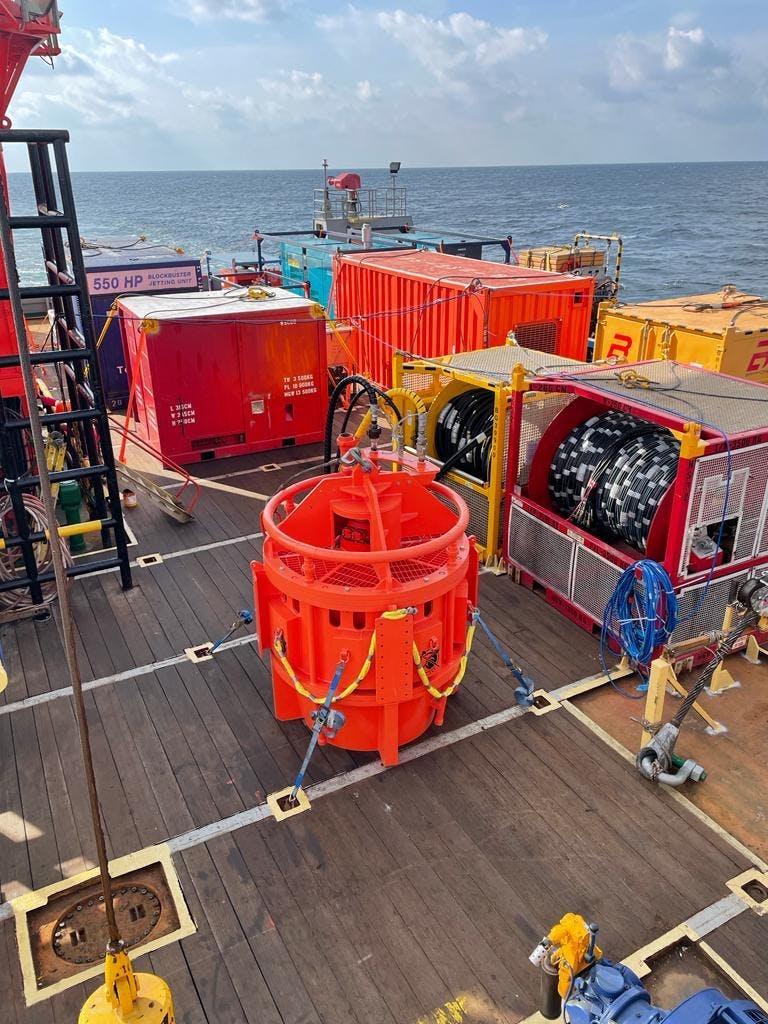Controlled flow excavation technology assists with subsea cable needs
By Ariana Hurtado, Editor and Director of Special Reports
Scotland-based JBS Group recently secured its first major US contract for an offshore wind development. Its Sea Axe controlled flow excavation (CFE) technology, designed for subsea operations, was chosen for this project due to its non-intrusive excavation methods.
As offshore wind power grows in the US, the company says Sea Axe will continue to support cable installation and burial operations.
The Sea Axe system, with a high flow rate, is designed to bury pipelines, cables and other subsea infrastructure safely and efficiently.
“Sea Axe is an advanced hybrid CFE system, using all volume and no pressure, high-volume water jets to erode the seabed naturally,” Jo McIntosh, sales and marketing director with JBS, told Offshore. “Unlike traditional mechanical excavation methods that can cause significant disturbance to marine life, Sea Axe’s water column ‘fluidizes’ the seabed, creating a controlled and non-intrusive excavation process.”
The company says the system works through natural erosion, minimizing disruption to marine habitats, which is necessary in renewables sector where firms must comply with stringent environmental regulations.
“This approach not only protects marine life but also ensures that projects can be completed without the ecological footprint often associated with traditional excavation methods,” McIntosh said.
Sea Axe can remain submerged for extended periods of up to 72 hours, which allows for long, uninterrupted work scopes. “This contributes to operational efficiency while keeping environmental disturbances to a minimum,” McIntosh added.
Case studies
Spanning 124 miles, the Greenlink interconnector project connects the electricity grids of Ireland and Wales. Sea Axe was deployed in the interconnector project, ensuring the subsea cables were securely buried, even in the face of challenging seabed conditions. Its adaptability to varying seabed types, from soft sediments to harder rock formations, proved essential in delivering the project on time and with minimal environmental impact, McIntosh said.
The Sea Axe also played a role in the 475-mile HVDC interconnector between Denmark and the UK, the world’s longest subsea power cable. Sea Axe delivered excavation to ensure the secure placement of the cables.
“Its real-time sonar monitoring capabilities allowed operators to adjust the flow rate in response to changing seabed conditions, ensuring maximum precision and minimal risk to cable infrastructure,” McIntosh added.
In addition to interconnector projects, Sea Axe has assisted in decommissioning and seabed leveling operations. In a Southern North Sea decommissioning project, the technology was deployed to safely uncover mattresses and grout bags, allowing for their recovery without incident. The CFE system removed these materials efficiently and safely.
Conclusion
JBS aims to align with the sector’s focus on environmental sustainability, and this is what the company considers one of the most significant benefits of its Sea Axe technology.
The company’s subsea services also include advanced fabrication, subsea engineering and material handling solutions for offshore operators. For example, the company manufactures chutes and A-frame systems, which it says are often in demand alongside the Sea Axe for safe deployment and recovery.
The company also fabricates subsea structures supporting a variety of offshore activities, from pipeline installation to decommissioning efforts. These systems are designed to endure the harsh marine environments.
“JBS has successfully executed and supplied its innovations and expertise across 80 countries,” McIntosh concluded.
About the Author
Ariana Hurtado
Editor-in-Chief
With more than a decade of copy editing, project management and journalism experience, Ariana Hurtado is a seasoned managing editor born and raised in the energy capital of the world—Houston, Texas. She currently serves as editor-in-chief of Offshore, overseeing the editorial team, its content and the brand's growth from a digital perspective.
Utilizing her editorial expertise, she manages digital media for the Offshore team. She also helps create and oversee new special industry reports and revolutionizes existing supplements, while also contributing content to Offshore's magazine, newsletters and website as a copy editor and writer.
Prior to her current role, she served as Offshore's editor and director of special reports from April 2022 to December 2024. Before joining Offshore, she served as senior managing editor of publications with Hart Energy. Prior to her nearly nine years with Hart, she worked on the copy desk as a news editor at the Houston Chronicle.
She graduated magna cum laude with a bachelor's degree in journalism from the University of Houston.


